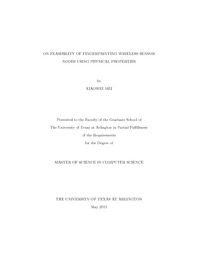
ATTENTION: The works hosted here are being migrated to a new repository that will consolidate resources, improve discoverability, and better show UTA's research impact on the global community. We will update authors as the migration progresses. Please see MavMatrix for more information.
Show simple item record
| dc.contributor.author | Mei, Xiaowei | en_US |
| dc.date.accessioned | 2012-07-25T19:22:44Z | |
| dc.date.available | 2012-07-25T19:22:44Z | |
| dc.date.issued | 2012-07-25 | |
| dc.date.submitted | January 2012 | en_US |
| dc.identifier.other | DISS-11645 | en_US |
| dc.identifier.uri | http://hdl.handle.net/10106/11151 | |
| dc.description.abstract | Fingerprinting wireless devices using physical properties has been recently suggested as an alternative for device identification and authentication. It has been found that the clock skew caused by the frequency discrepancy of the quartz crystals in different devices can be used as a reliable source for fingerprinting. Researchers have studied the application of the clock skew-based fingerprinting in sensor networks and claimed that it can detect fake identities, wormholes, and node replicas. However, the study in this paper draws a completely opposite conclusion, i.e., the clock skew of sensor nodes can be easily forged by adversaries to evade the detection. This paper then studies the feasibility of using the distribution of signal power in space to fingerprint sensor nodes. The result shows that a sensor node's signal power distribution in space is not only reliable for being used as a source for fingerprinting but also very hard to forge. Finally, the paper discusses the application of using signal power distribution for detecting various attacks as well as the limitations and open problems. | en_US |
| dc.description.sponsorship | Liu, Donggang | en_US |
| dc.language.iso | en | en_US |
| dc.publisher | Computer Science & Engineering | en_US |
| dc.title | On Feasibility Of Fingerprinting Wireless Sensor Nodes Using Physical Properties | en_US |
| dc.type | M.S. | en_US |
| dc.contributor.committeeChair | Liu, Donggang | en_US |
| dc.degree.department | Computer Science & Engineering | en_US |
| dc.degree.discipline | Computer Science & Engineering | en_US |
| dc.degree.grantor | University of Texas at Arlington | en_US |
| dc.degree.level | masters | en_US |
| dc.degree.name | M.S. | en_US |
Files in this item
- Name:
- Mei_uta_2502M_11645.pdf
- Size:
- 743.0Kb
- Format:
- PDF
This item appears in the following Collection(s)
Show simple item record


